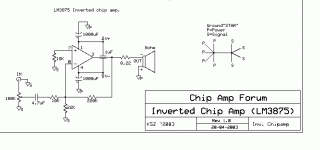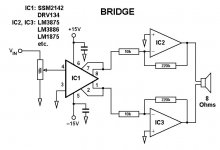Hello,
I just built a bridged LM3875 with Burrbrown's DRV134 chip. I heard strange "zzzzzzzzzzzzzzz" noise exactly like when we listen to an AM/FM tuner without station. The noise was not much loud and it remained on a particular level no matter how much I adjusted a volume knob.
- The output signal of DRV134 is feeded to each of LM3875 board.
- The schematic of LM3875 board is based on the picture below.
- Without bridge, the LM3875 board alone works perfectly.
Need your advices please........
I just built a bridged LM3875 with Burrbrown's DRV134 chip. I heard strange "zzzzzzzzzzzzzzz" noise exactly like when we listen to an AM/FM tuner without station. The noise was not much loud and it remained on a particular level no matter how much I adjusted a volume knob.
- The output signal of DRV134 is feeded to each of LM3875 board.
- The schematic of LM3875 board is based on the picture below.
- Without bridge, the LM3875 board alone works perfectly.
Need your advices please........
Attachments
Oops.....sorry for ambiguity 
According to the circuit diagram, I have two LM3875 boards without volume. Instead, the volume was installed at the input of DRV134.
The V+ signal from DRV134 was sent to 4.7uf cap at the first LM3875 board. And the V- signal of the same DRV134 was sent to the other LM3875 board.
Both LM3875 chips were set up in the inverted mode (see picture).
And no buffer circuitry is used.

According to the circuit diagram, I have two LM3875 boards without volume. Instead, the volume was installed at the input of DRV134.
The V+ signal from DRV134 was sent to 4.7uf cap at the first LM3875 board. And the V- signal of the same DRV134 was sent to the other LM3875 board.
Both LM3875 chips were set up in the inverted mode (see picture).
And no buffer circuitry is used.
I have buzzing problem with my single chip LM3875 amp (chipamp.com). It's not ground loop buzzing or natural background noise. It's something else.
Try moving the speaker cables. Does it change the sound somehow.
I tried several things to get rid of the interference but I haven't found out the solution. (zobel network, inductor and ferrites in speaker cables, better power supply bypassing, caps in +/- pins in LM3875, different speakers, shielded and shorter speakercables etc. etc....). I hope to solve the problem by installing the amplifier pcb in the same enclosure with the power supply. Now the power supply is connected via braided cable which is about 0,5 metres long.
Funny thing is that the problem occurs only in one floor in my house. The interference is not coming from my house. I made sure of that by unplugging all other electricity from the house.
Do you have any potential interference sources like switched-mode power supply.
Try moving the speaker cables. Does it change the sound somehow.
I tried several things to get rid of the interference but I haven't found out the solution. (zobel network, inductor and ferrites in speaker cables, better power supply bypassing, caps in +/- pins in LM3875, different speakers, shielded and shorter speakercables etc. etc....). I hope to solve the problem by installing the amplifier pcb in the same enclosure with the power supply. Now the power supply is connected via braided cable which is about 0,5 metres long.
Funny thing is that the problem occurs only in one floor in my house. The interference is not coming from my house. I made sure of that by unplugging all other electricity from the house.
Do you have any potential interference sources like switched-mode power supply.
Mrpong said:Oops.....sorry for ambiguity
well, i now see that there was no ambiguity, it was lack of information i had. the problem seems to be more serious than i thought. may be there is ground loop somewhere when you connect the amps.
Are you familiar with this document. It's about bridge and parallel chipamps.
http://www.national.com/an/AN/AN-1192.pdf
http://www.national.com/an/AN/AN-1192.pdf
jaudio,
I read your thread about hiss.
http://www.diyaudio.com/forums/showthread.php?threadid=52432&perpage=10&highlight=&pagenumber=3
For my case, the input and feedback resistors are 10K and 220K respectively. Therefore the gain is 22. Is this too high for bridge configuration?
I read your thread about hiss.
http://www.diyaudio.com/forums/showthread.php?threadid=52432&perpage=10&highlight=&pagenumber=3
For my case, the input and feedback resistors are 10K and 220K respectively. Therefore the gain is 22. Is this too high for bridge configuration?
Mrpong said:jaudio,
I read your thread about hiss.
http://www.diyaudio.com/forums/showthread.php?threadid=52432&perpage=10&highlight=&pagenumber=3
For my case, the input and feedback resistors are 10K and 220K respectively. Therefore the gain is 22. Is this too high for bridge configuration?
Try changing the input resistor to 1k and the feedback to 11k. I don't think your rail voltage is too high you are well within the supply rating. Have you tried connecting your ground to earth ground? I had a cranky setup once that had an annoying hiss until I connected the earth ground (yes I know this is not necessarily recomended). What kind of supply do you have feeding the DRV134, do you have bypass capacitors on the supply pins?
Best of luck!
G.
FYI:
LAYOUT CONSIDERATIONS
A driver/receiver balanced-pair (such as the DRV134 and
INA137) rejects the voltage differences between the grounds
at each end of the cable, which can be caused by ground
currents, supply variations, etc. In addition to proper bypassing,
the suggestions below should be followed to achieve
optimal OCMR and noise rejection.
As is the case for any single-ended system, the source¡¯s
common should be connected as close as possible to the
DRV134's ground. Any ground offset errors in the source
will degrade system performance.
Symmetry on the outputs should be maintained.
Shielded twisted-pair cable is recommended for all applications.
Physical balance in signal wiring should be maintained.
Capacitive differences due to varying wire lengths
may result in unequal noise pickup between the pair and
degrade OCMR. Follow industry practices for proper system
grounding of the cables.(Copy from Drv134 datasheet page 10)
Zang
LAYOUT CONSIDERATIONS
A driver/receiver balanced-pair (such as the DRV134 and
INA137) rejects the voltage differences between the grounds
at each end of the cable, which can be caused by ground
currents, supply variations, etc. In addition to proper bypassing,
the suggestions below should be followed to achieve
optimal OCMR and noise rejection.
As is the case for any single-ended system, the source¡¯s
common should be connected as close as possible to the
DRV134's ground. Any ground offset errors in the source
will degrade system performance.
Symmetry on the outputs should be maintained.
Shielded twisted-pair cable is recommended for all applications.
Physical balance in signal wiring should be maintained.
Capacitive differences due to varying wire lengths
may result in unequal noise pickup between the pair and
degrade OCMR. Follow industry practices for proper system
grounding of the cables.(Copy from Drv134 datasheet page 10)
Zang
neutron7 said:I think you have a ground/noise problem on the DRV part of the circuit which the bridged amplifiers are somewhat cancelling out.
can you use a scope to chack the DRV outputs, or if not a scope, use a small amplifier/speaker to listen to the DRV outputs.
Have you tried this? Are the 3875s working properly,have you test each lm3875 separately?
Are your amps monoblocks and one stereo amp?
jaudio said:
Have you tried this? Are the 3875s working properly,have you test each lm3875 separately?
Are your amps monoblocks and one stereo amp?
Yeah..as I explained in post #1, the LM3875 board alone works perfectly without hum and hisss. Actually this is just my experiment including three separate boards (one DRV134 board and two LM3875 boards).
DRV134 problems???
A. Whats powering your DRV134, regulated or shunts and what voltage?
B. Are your power supply pins V+ V- bypassed to gound with a 1uf or similar cap?
C. Are you useing 10uf NP caps on the sense lines?
D. Are you useing the suggested 300ohm resistors on the outputs?
and if you are, are they in conjunction with 1Kohm input resistors on the LM3875 boards?
E. Do you have an input network on the DRV? i.e. 1k input resistor 22k shunt and 220pf bypass.
F. Have you issolated the power and input grounds form the LM3875 boards from the DRV134, it is sometimes very important to lift the grounds...............
G. Our your output R/L going to the R/L sense lines ?
H. Input cap?? what value??
The DRV can be very particular about power supply, supply bypassing and ground potentials. And if your supply is noisy and your sense lines are wrong you will have ripple through the DRV in proportion to the DRV's gain.
A. Whats powering your DRV134, regulated or shunts and what voltage?
B. Are your power supply pins V+ V- bypassed to gound with a 1uf or similar cap?
C. Are you useing 10uf NP caps on the sense lines?
D. Are you useing the suggested 300ohm resistors on the outputs?
and if you are, are they in conjunction with 1Kohm input resistors on the LM3875 boards?
E. Do you have an input network on the DRV? i.e. 1k input resistor 22k shunt and 220pf bypass.
F. Have you issolated the power and input grounds form the LM3875 boards from the DRV134, it is sometimes very important to lift the grounds...............
G. Our your output R/L going to the R/L sense lines ?
H. Input cap?? what value??
The DRV can be very particular about power supply, supply bypassing and ground potentials. And if your supply is noisy and your sense lines are wrong you will have ripple through the DRV in proportion to the DRV's gain.
- Status
- This old topic is closed. If you want to reopen this topic, contact a moderator using the "Report Post" button.
- Home
- Amplifiers
- Chip Amps
- A strange problem with bridged LM3875

 Unfortunately, I don't have a scope.
Unfortunately, I don't have a scope.